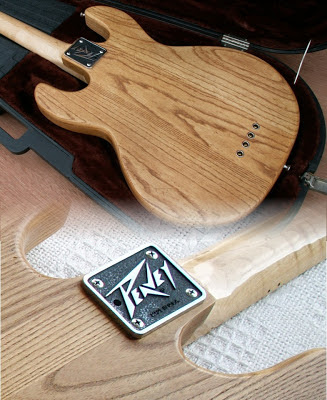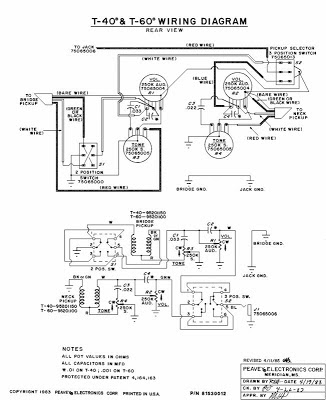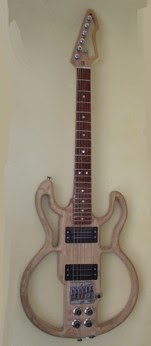Guitar
I had intended to do this last week but time ran away with me.
So, to the next part.
Below is part of the e.mail I sent to Chip and his response.
Once again, fascinating reading!

Having a good response to the feature - reader numbers have gone up
by over a hundred a day - around 800 for the week!!
I think you has answered this one before - the Peavey script on the neck
plate is upside down so when you rotate the guitar, so the back is to the
audience (Hendrix style) "Peavey" is the correct way up??
I know you have covered this one quite a lot and you would have perhaps
preferred a more simple arrangement, although a lot of owners like the
feature - the circuit!
How did you and Hartley find yourself going down that route?
An idea you/he had or was it offered to you? Red Rhodes designed?
You also have said that the T-40 pick-up would have been different,
if you had your time over again.
To me and thousands of owners, it sounds like a T-40 and several
other basses, when selecting all the different options but you would
have done it differently?
The Ash body was chosen for marketing purposes?
Looks good under a Sunburst and in those days weight meant
better tone/sustain?
Are the plain colours Poplar?

Eric;
I'm happy for you that the readership is climbing. I think your style of writing
might have a lot to do with this.
The Indians, of North America, at least, wore their necklaces or such, so that
they could see it right-side-up, as they believed themselves to be the center of
the universe.
We modern persons wear necklaces for others to see, hence their positioning.
We, Hartley and I, figured the person wearing the guitar or bass, already knew
what brand it was, so made the neckplate to read properly when the one holding
the instrument held it out and rotated it for the viewer to read.
The first I heard of the Red Rhodes circuit was when Hartley told me about the
new clever circuit that Red Rhodes gave to Hartley.
I have, or had, no way to know whether Red thought of it or if it was something
that was passed around.
At the time, I could see no harm in using the circuitry, so went along with it.
I have since learned that the circuit bled some trebles through the tone pot to
ground all the time.
It seems as if we should have had 300k ohm pots made to prevent the overtones
we were unknowingly losing.
I now cut or unsolder the red centertap wire to prevent the leakage of high overtones.
I also remove the chrome covers from the pickups and hear a much more pleasing
sound, (to my ear).
I also designed the input of the signal from the pickups to enter the pot through the
middle lug, a practice that most pot manufacturers insist on.
Gibson and Fender bring the signal in through an outside lug which gives an
unwanted side effect.
That is, if both pickups are on together, when you change the volume or tone of either,
it affects both pickups. They are interdependent.
Wiring the signal to the center lug removes the interdependence, giving more control
over the tone; moving either volume or tone of one pickup doesn't affect the other pickup.
I am finding that the T-60 pickup is a better bass pickup in that it has some pleasing
treble overtones that fill out the sound in a way that's pleasing to my ears.
These overtones can be eliminated with the tone pot if so desired.
However, you just can't get them through the added resistance of the added length of
coil wire of the larger T-40 pickups.
Since resistance inhibits treble tones, and both T-40 and T-60 pickups have about
the same number of turns of wire, the T-40 pickups lack some nice sounds I'm
finding on my short-scale basslets.
I'm using the 25.5" fret scale to make it more familiar to anyone who plays guitar
also. Surprisingly, the 22" scale bass sounds very nice, but, unfortunately,
look like a toy.
Neil Diamond's lead guitar player uses the 24.75" scale basslet in the studio for
its sound.

Ash sunburst bodies still had the weight of the natural wood models and are relatively
rare, when compared to the other color options.
We introduced the solid color instruments so that we could use the much lighter Poplar
wood for bodies.
We had the Ash bodies for weight, although both Hartley and I knew that weight didn't
mean more sustain.
He told me that "We were the "new kids on the block" so we dare not make too many
waves until we were established.
Many years after I had left Peavey, I made a skeleton T-60 to prove beyond a doubt
that you could get equal sustain.
Chip.
In terms of tone, sustain, brightness, volume etc, there is always going to be a
slight variation but in real terms, the sound of the Ash and Poplar bodies are
pretty much identical - it would be very hard to determine one or the other,
if it was a blind testing.
The Wine coloured T-60 I have, shown a couple of posts ago, is one of the
sweetest guitars you could ever wish to play.
Next time, more from Chip - Toasters to Blades - Slab to Contoured.
Cheers. :)
- Peavey T-40 And T-60 Users And Literature. .
Peavey were keen to let it be known that their guitars were being used by major artists, at the time - perhaps the most famous, was Ross Valory of the band, Journey. There was also Leon Medica of Le Roux and Banner Thomas from Molly...
- Peavey T-60 And T-40 Story And A Happy Christmas. . . . :)
Well, another year almost gone by again! Christmas is almost upon us, the shortest day of the year and tomorrow the days start to get longer. Yippeee! The next set of questions I asked Chip, were as usual, answered in great detail....
- Peavey T-60, T-40, Chip Todd - Hartley Peavey - "take From The Top!". . .
As I said in one of my previous posts, I am very lucky to have a substantial input from Chip, himself and I am grateful for the time he has put into it and he has indicated there is more to come. I you own, or have owned a Peavey T Series guitar,...
- Peavey T-60 And Eighty Thousand Visitors. . .
Hi to all out there. As of today, over 80500 visits have been made to my blog. So, thanks for dropping in - the story continues. I first saw a Peavey "T" in late '78 or early '79, a T-60 - I can't remember exactly when but I do...
- Peavey T-40 And T-60, The Begining. . . .
Peavey T-40 and T-60 - Bass & Guitar. How far is it back to the beginning?? 1822!! "You're Kidding"!!! Well, sort of! Way back, Thomas Blanchard invented a machine to make gun stocks all the same shape. See picture of Thomas and...
Guitar
Peavey T-40 and T-60, Neck plate, Circuit and Ash. . . . .
I had intended to do this last week but time ran away with me.
So, to the next part.
Below is part of the e.mail I sent to Chip and his response.
Once again, fascinating reading!

Having a good response to the feature - reader numbers have gone up
by over a hundred a day - around 800 for the week!!
I think you has answered this one before - the Peavey script on the neck
plate is upside down so when you rotate the guitar, so the back is to the
audience (Hendrix style) "Peavey" is the correct way up??
I know you have covered this one quite a lot and you would have perhaps
preferred a more simple arrangement, although a lot of owners like the
feature - the circuit!
How did you and Hartley find yourself going down that route?
An idea you/he had or was it offered to you? Red Rhodes designed?
You also have said that the T-40 pick-up would have been different,
if you had your time over again.
To me and thousands of owners, it sounds like a T-40 and several
other basses, when selecting all the different options but you would
have done it differently?
The Ash body was chosen for marketing purposes?
Looks good under a Sunburst and in those days weight meant
better tone/sustain?
Are the plain colours Poplar?
Eric;
I'm happy for you that the readership is climbing. I think your style of writing
might have a lot to do with this.
The Indians, of North America, at least, wore their necklaces or such, so that
they could see it right-side-up, as they believed themselves to be the center of
the universe.
We modern persons wear necklaces for others to see, hence their positioning.
We, Hartley and I, figured the person wearing the guitar or bass, already knew
what brand it was, so made the neckplate to read properly when the one holding
the instrument held it out and rotated it for the viewer to read.
The first I heard of the Red Rhodes circuit was when Hartley told me about the
new clever circuit that Red Rhodes gave to Hartley.
I have, or had, no way to know whether Red thought of it or if it was something
that was passed around.
At the time, I could see no harm in using the circuitry, so went along with it.
I have since learned that the circuit bled some trebles through the tone pot to
ground all the time.
It seems as if we should have had 300k ohm pots made to prevent the overtones
we were unknowingly losing.
I now cut or unsolder the red centertap wire to prevent the leakage of high overtones.
I also remove the chrome covers from the pickups and hear a much more pleasing
sound, (to my ear).
I also designed the input of the signal from the pickups to enter the pot through the
middle lug, a practice that most pot manufacturers insist on.
Gibson and Fender bring the signal in through an outside lug which gives an
unwanted side effect.
That is, if both pickups are on together, when you change the volume or tone of either,
it affects both pickups. They are interdependent.
Wiring the signal to the center lug removes the interdependence, giving more control
over the tone; moving either volume or tone of one pickup doesn't affect the other pickup.
I am finding that the T-60 pickup is a better bass pickup in that it has some pleasing
treble overtones that fill out the sound in a way that's pleasing to my ears.
These overtones can be eliminated with the tone pot if so desired.
However, you just can't get them through the added resistance of the added length of
coil wire of the larger T-40 pickups.
Since resistance inhibits treble tones, and both T-40 and T-60 pickups have about
the same number of turns of wire, the T-40 pickups lack some nice sounds I'm
finding on my short-scale basslets.
I'm using the 25.5" fret scale to make it more familiar to anyone who plays guitar
also. Surprisingly, the 22" scale bass sounds very nice, but, unfortunately,
look like a toy.
Neil Diamond's lead guitar player uses the 24.75" scale basslet in the studio for
its sound.
Ash sunburst bodies still had the weight of the natural wood models and are relatively
rare, when compared to the other color options.
We introduced the solid color instruments so that we could use the much lighter Poplar
wood for bodies.
We had the Ash bodies for weight, although both Hartley and I knew that weight didn't
mean more sustain.
He told me that "We were the "new kids on the block" so we dare not make too many
waves until we were established.
Many years after I had left Peavey, I made a skeleton T-60 to prove beyond a doubt
that you could get equal sustain.
Chip.
In terms of tone, sustain, brightness, volume etc, there is always going to be a
slight variation but in real terms, the sound of the Ash and Poplar bodies are
pretty much identical - it would be very hard to determine one or the other,
if it was a blind testing.
The Wine coloured T-60 I have, shown a couple of posts ago, is one of the
sweetest guitars you could ever wish to play.
Next time, more from Chip - Toasters to Blades - Slab to Contoured.
Cheers. :)
- Peavey T-40 And T-60 Users And Literature. .
Peavey were keen to let it be known that their guitars were being used by major artists, at the time - perhaps the most famous, was Ross Valory of the band, Journey. There was also Leon Medica of Le Roux and Banner Thomas from Molly...
- Peavey T-60 And T-40 Story And A Happy Christmas. . . . :)
Well, another year almost gone by again! Christmas is almost upon us, the shortest day of the year and tomorrow the days start to get longer. Yippeee! The next set of questions I asked Chip, were as usual, answered in great detail....
- Peavey T-60, T-40, Chip Todd - Hartley Peavey - "take From The Top!". . .
As I said in one of my previous posts, I am very lucky to have a substantial input from Chip, himself and I am grateful for the time he has put into it and he has indicated there is more to come. I you own, or have owned a Peavey T Series guitar,...
- Peavey T-60 And Eighty Thousand Visitors. . .
Hi to all out there. As of today, over 80500 visits have been made to my blog. So, thanks for dropping in - the story continues. I first saw a Peavey "T" in late '78 or early '79, a T-60 - I can't remember exactly when but I do...
- Peavey T-40 And T-60, The Begining. . . .
Peavey T-40 and T-60 - Bass & Guitar. How far is it back to the beginning?? 1822!! "You're Kidding"!!! Well, sort of! Way back, Thomas Blanchard invented a machine to make gun stocks all the same shape. See picture of Thomas and...
